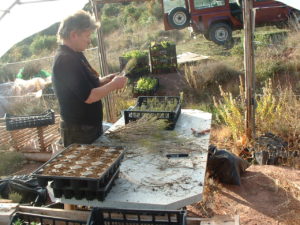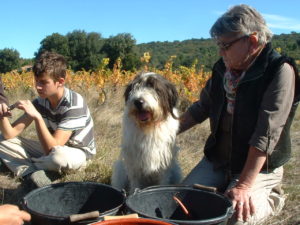 January is a real transition month here at Montrouch. The days are still too short and the nights too long. We have to be careful with the electricity, the short days, even if sunny, do not give us enough power to run the big stuff, the fridge freezer and the broad screen telly. Evenings consist of marathon backgammon sessions by candle light, with the “interesting” telly slot of 9pm to 11pm watched, if there is anything decent to watch, to the background hum of the generator. It is time to catch up on our annual reading.
January is a real transition month here at Montrouch. The days are still too short and the nights too long. We have to be careful with the electricity, the short days, even if sunny, do not give us enough power to run the big stuff, the fridge freezer and the broad screen telly. Evenings consist of marathon backgammon sessions by candle light, with the “interesting” telly slot of 9pm to 11pm watched, if there is anything decent to watch, to the background hum of the generator. It is time to catch up on our annual reading.
I have stopped doing my weekly markets in Prepignan and Lezignan-Corbieres, although Caroline continues every Saturday in Narbonne. Her gluten free pizza and fruit cake help to keep it viable. Money is tight, not least because the big bills from the tax and MSA hit in the Autumn.
Although our work rate has dropped off there is till no shortage of things to do in the brief daylight hours. First is wood, I always mean to plan ahead and get enough cut to last us through the winter, I rarely do. Once Spring hits it is all hands on deck to get ready for the new season. So as a result I am always cutting wood in a just on time delivery way. Slowly but surely the woodland around the Domaine is getting into order. Because the forest around us has not effectively been managed, and is, in forest terms, quite young I have a certain approach, as out lined here, Montrouch and our Forest, which while being good for the forest is not so hot for our woodpile as it means leaving the big trees intact and feeling the smaller ones with the resulting loss in yield. It is a lot of work, but once I have either chipped or burnt the remaining scrub should go someway to protect us from fires as well as have a lasting impact on our immediate environment.
January is also a time of preparation, the sunny days means that corriander and parsley, albeit slowly, will germinate and grow in the poly tunnel, it is also possible to take heel cuttings of some garrigue plants, like Thyme, Winter Savoury and Rosemary. The Latifolia Thyme can also be dug up and split.
We have done the inventory of our seeds, and I have just finished re ordering the seeds for the season to come. We use two main suppliers, Essembio for vegetables and Agrosemens for the aromatics_ they work out slightly cheaper than each other in both fields. I find the quality from both very good, and the both sales teams are very helpful and committed to organic.
The big job that is the poly tunnel awaits, it needs completely clearing out, the tables remade, and two ends putting on. A big but necessary job, we don’t heat the tunnel, preferring a natural approach so the plants are acclimatized to the local weather, but it does mean that we are a clear month head of the season each year.
This season we are going to do something we have not done before and that is reach out for help from our friends. It is not uncommon for local small producers to do this at times of heavy work. This year we have done the lavender harvest at Manu and Chrisophe’s and the wine harvest at Dom’s, next week we will be taught how to clip vines so we can help Dom clip his 10 hectares of vines. Our big job is the vegetables, we have 500 of each of the 16 varieties of tomatoes we grow, 100 of each of the three courgettes and four cucumber varieties we grow and a fair few gherkins seeds remaining from last year. It amounts to a lot of seeds to put in as each require their own individually labelled pot. The pots have to be marked because if the wind blows over your stand, which it does from time to time, I’ll be damned if I can tell the difference between on variety of young tomato plant from another. So as I said it is a big job, the pots need to be marked, then filled with soil, watered, then the seeds individually placed, then recovered with soil, then packed into boxes and laid out on the pallets and tables in the poly tunnel.
We floated the idea of help a few weeks back and the response has been very, very positive It is hard work for our volunteers, and us, but it is fun too. The format whether lavender, vines or tomato plants is usually the same. You welcome the crew and make the introductions over coffee and croissants, then the work schedule and explications of what is what and the hows and whys is done. The work is done over lots of chatting and jokes. Lunch is the key
event of the day. It is vitally important that the work is finished by lunchtime, so lunch can be served late. It is the hosts responsibility to ensure that the workers are well fed and limitless quantities of wine are available. Mostly organic or locally produced naturally. I have very fond, if a little hazy, memories of eating freshly grilled organic veal and pork chops in the middle of St Auriol’s vines over looking Caunette en Val, while tasting the various wines of
the four winemakers that were helping out Dom with his vendage.
It is shaping up to be a good day or two’s work, but it takes a lot of work to get ready for. But there is a lot of January left.
Now I just have to update our 2018 catalog for vegetables and herbs, get the texts sorted out, and the design and this year do an English language version.
The really exiting news is that already the tarragon, wild geraniums, mints and even the Rau Ram is starting push through.



